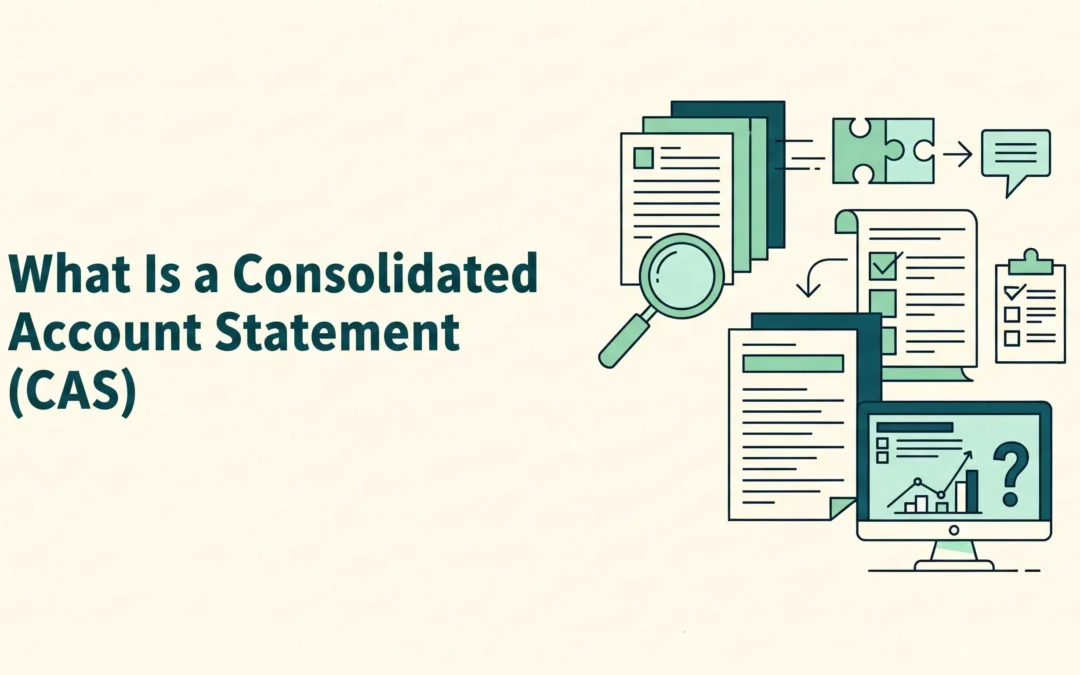In today’s time, many people are starting to invest from an early age. Everything has become accessible with the growing technological advancements. But not everyone has awareness about finance. They just follow what others are doing but fail to understand it properly. Consolidated Account Statement (CAS) is one such thing that is often ignored by the investor but is very useful.
This article will help you understand the meaning of CAS along with where it is accessible and how to read it.
What is a Consolidated Account Statement?
Investors can view all of their securities and mutual fund holdings connected to a single PAN in a single, cohesive financial report called a Consolidated Account Statement (CAS). The CAS is issued by India’s two main depositories, NSDL and CDSL.
It is intended to assist investors in managing, monitoring, and evaluating their investments across various platforms in a single location. By offering thorough records of holdings, transactions, and charges in mutual fund folios and demat accounts, it streamlines portfolio management.
Key Features:
- Unified View: Shows all demat and mutual fund investments connected to a PAN.
- Frequency: If there is a transaction, it is sent monthly; if not, it is sent half-yearly.
- PAN-Based Consolidation: CAS unifies all investments under a single PAN, irrespective of their location.
- Detailed Portfolio Snapshot: Displays market value, NAV, number of units or shares, fund/stock names, and ISIN codes.
- Transaction History: Contains dates for SIPs, dividend payments, redemptions, buy/sell records, and more.
- Cost Tracking: Provides a list of applicable fees such as stamp duty, securities transaction tax (STT), and transaction charges; however, not all demat account fees may be itemised in the CAS.
Example of a CAS:
| Date | Scheme | Type of Transaction | Units | NAV / Price | Market Value |
| 15-May-24 | ICICI Prudential Bluechip | SIP Purchase | 10 | Rs. 76.50 | Rs. 765.00 |
| 20-May-24 | Infosys Ltd (Demat) | Share Buy | 5 | Rs. 1,450.00 | Rs. 7,250.00 |
| 25-May-24 | SBI Balanced Advantage | Dividend Reinvested | 1.2 | Rs. 53.20 | Rs. 63.84 |
How to Access and Read a CAS?
1. Method 1: Via NSDL (for holders of NSDL accounts)
- Go to: https://cas.nsdl.com
- The option of “Consolidated Account Statement (CAS)” should be selected.
- Enter the required details:
- Your PAN
- Client ID and DP Name (if required)
- Your depository’s registered email address or mobile number
- Select the statement period (quarterly, monthly, etc.).
- Press the Submit button.
- Your registered email address will receive the CAS via email as a password-protected PDF.
2. Method 2: Via CDSL (for holders of CDSL accounts)
- Go to: https://www.cdslindia.com
- Navigate to the Consolidated Account Statement (CAS).
- Enter your registered email address and PAN.
- Decide on a deadline and submit.
- Your CAS will be sent to you via email, usually in a few minutes.
Note: Format for Passwords
- Open the PDF on your device that you received via email.
- PAN in uppercase, then
- Birthdate (DDMMYYYY)
For instance, PAN: ABCDE1234F, DOB: January 1, 2000
Then, password: ABCDE1234F01012000
How to Read a CAS?
1. Check for the Investor Information
- Your email, PAN, and name
- Helpful for confirming the accuracy of personal information prior to filing taxes or completing KYC
2. Holdings of Mutual Funds
Displays information about your investments in mutual funds across all AMCs (Asset Management Companies) connected to your PAN.
| Terms | Meaning |
| AMC Name | Mutual fund company (e.g., SBI MF, ICICI Prudential) |
| Scheme Name | Fund name (e.g., HDFC Balanced Advantage Fund) |
| Folio Number | Unique number assigned by the fund house |
| Units Held | Number of mutual fund units owned |
| NAV (Rs.) | Net Asset Value per unit on the statement date |
| Market Value (Rs.) | Total worth of your investment = Units × NAV |
| Transaction Date | Date of purchase, redemption, dividend reinvestment, etc. |
3. Holding in Demat Account
All of your stocks, bonds, ETFs, and SGBs in your demat account are covered in this section.
| Terms | Meaning |
| ISIN Code | Unique 12-digit code identifying the security |
| Security Name | Name of stock or instrument (e.g., TCS, Reliance SGB) |
| Quantity Held | Number of shares/units |
| Market Price | Current market price per share |
| Market Value | Quantity × Market Price |
4. Transaction Summary:
A list of every transaction that was made during that time period, is presented chronologically. This will help you know where and when you are investing money at a glance.
Example:
| Date | Type of Transaction | Scheme / Security | Amount (Rs.) | Units / Shares |
| 01-Apr-24 | SIP Purchase | Axis Bluechip Fund | 1,000 | 12.5 |
| 10-Apr-24 | Share Buy | Infosys Ltd | 7,250 | 5 |
Bottomline
The conclusion can be drawn that CAS is extremely important for tracking your transactions. It clearly states all the information clearly that is helpful in analysing one’s personal finances. It can be easily accessed from the websites stated above by following the right steps. Reading this report is also very easy and convenient.
It is advised to do research on an individual level and then only invest in any kind of investment option. Having basic knowledge will facilitate the investing activity along with tracking it.


